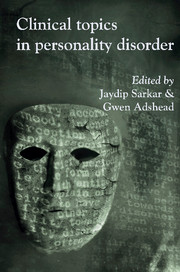Book contents
- Frontmatter
- Contents
- List of tables
- List of boxes
- List of figures
- List of contributors
- Foreword
- Part 1 The nature of the problem
- 1 The nature of personality disorder
- 2 Differences between psychopathy and other personality disorders: evidence from neuroimaging
- 3 Challenges in the treatment of dangerous and severe personality disorder
- 4 Are you looking at me? Understanding and managing paranoid personality disorder
- 5 Personality disorder in older people: how common is it and what can be done?
- 6 Management of common personality disorders in the acute setting
- 7 Personality disorder in women
- 8 Personality disorder in adolescence
- Part 2 Management and general treatment approaches
- Part 3 Specific treatment approaches
- Index
7 - Personality disorder in women
from Part 1 - The nature of the problem
Published online by Cambridge University Press: 02 January 2018
- Frontmatter
- Contents
- List of tables
- List of boxes
- List of figures
- List of contributors
- Foreword
- Part 1 The nature of the problem
- 1 The nature of personality disorder
- 2 Differences between psychopathy and other personality disorders: evidence from neuroimaging
- 3 Challenges in the treatment of dangerous and severe personality disorder
- 4 Are you looking at me? Understanding and managing paranoid personality disorder
- 5 Personality disorder in older people: how common is it and what can be done?
- 6 Management of common personality disorders in the acute setting
- 7 Personality disorder in women
- 8 Personality disorder in adolescence
- Part 2 Management and general treatment approaches
- Part 3 Specific treatment approaches
- Index
Summary
Summary This chapter explores differences in the way in which personality disorders manifest in the two genders and considers possible biopsychosocial reasons underlying such differences. It looks at common clinical presentations in women with personality disorders and attempts to provide an understanding of these. It concludes by highlighting the need for gender-specific services and approaches, and for workforce development and support to meet the needs of this group.
Numerous studies have shown an association between personality disorder and gender (Box 7.1), but explanations for this take various standpoints. For example, researchers have suggested:
• gender bias in the diagnostic criteria for certain personality disorders
• differences in rates of personality disorders in the two genders
• differing behavioural manifestation of traits across gender lines
• differences in trait distribution across the two genders
• clinician bias in diagnosing certain personality disorders.
Let us consider each of these in turn. First, there is indeed evidence that gender bias within the American Psychiatric Association's DSM diagnostic criteria leads to disproportionately high rates of histrionic personality disorder among women, although the five-factor model of personality (openness, conscientiousness, extraversion, agreeableness and neuroticism) is less prone to this (Samuel & Widiger, 2009). Stereotypically feminine traits have been caricatured in the DSM diagnosis. Some have made feminist claims that healthy women can earn the diagnosis of histrionic personality disorder because of the gender-biased criteria constructed by a task-force comprised largely of men (Kaplan, 1983). Although this is an extreme position, there is evidence that the criteria of antisocial personality disorder are heavily loaded in favour of characteristics associated with being male (Paris, 2004).
Box 7.1 Gender differences in personality disorders
• Women have higher rates of histrionic, borderline and dependent personality Disorders
• Men have higher rates of antisocial, narcissistic, schizoid and obsessive– compulsive personality disorders
• Men have higher rates of DSM cluster A disorders, but rates for clusters B and Care the same for the two genders
• There is diagnostic as well as clinician bias in the international criteria for antisocial personality disorder in men and histrionic personality disorder for women
• Gender differences are seen in major traits, e.g. impulsivity manifests as impulsive aggression and interpersonal exploitation in antisocial but in selfdestructive acts and mood instability in borderline personality disorder
- Type
- Chapter
- Information
- Clinical Topics in Personality Disorder , pp. 99 - 117Publisher: Royal College of PsychiatristsPrint publication year: 2012



